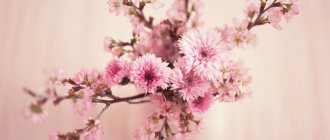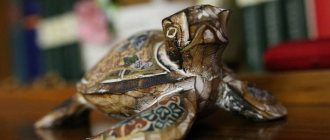The meaning of a fan in feng shui
The fan appeared in China a very long time ago. Previously, representatives of the stronger sex fanned themselves with it. Today it is considered a strong amulet and an erotic symbol.
The Chinese and Japanese attach great importance to it and hang it on the walls of their rooms. If you use a fan according to Feng Shui, you can protect your home from negative energy, envy and hatred of others. It also has other wonderful properties:
- attracts good luck in love;
- promotes business development;
- improves health;
- relieves fatigue and depression.
Fan on the wall
According to Chinese mythology, the wind goddess brought the fan to earth. She came down from heaven and gave it to people so that they would no longer suffer. If a person needed help, he had only to wave his fan, and the goddess would come to the rescue.
It is believed that, together with air currents, the Chinese fan carries favorable energy and gives its owner a surge of strength. Its wonderful properties are activated when the attribute is used correctly.
Charging a fan with energy is very simple. You need to fan yourself with it for several minutes. After this, you can feel cheerfulness and good mood. With each swing, it will attract chi energy, which can revive everything on our planet. Its flows circulate in people, animals and plants, pass through air and water. Without it there will be no growth and existence.
How to choose?
Color
There are no prohibitions in choosing a color; it is only important that the owner likes it. However, some beliefs regarding colors still exist:
- To attract good luck to your home, it is recommended to purchase a red fan;
- A golden fan will facilitate mutual understanding in the family. It is also considered to be a talisman of immortality;
- To improve health, get rid of the blues, chronic fatigue and depression, it is better to hang a talisman with images of bamboo, pines or cedars;
- To attract fame, a fan with a design of a peacock or an eagle will be useful;
- An amulet with the image of fish or a ship with a sail will help improve your financial condition and attract profit;
- To improve relationships between spouses, it is recommended to purchase a gold talisman with drawn paired figures;
- An amulet with blooming lotus, sakura or peonies will help you attract love.
Place
If you want to attract fame, the talisman should be placed in the south, and if you need more efficiency and energy at work, it is better to hang it behind your back. In other cases, it is recommended to place it on the east side.
Important! It is better not to place a golden fan above the head of the bed. This can lead to insomnia due to excess energy and imbalance.
How to activate
In order for the talisman to bring maximum benefit, it is necessary to use it more often for its intended purpose. You can feel a surge of positive energy and strength by simply fanning yourself with it for a few minutes.
Size
The amulet must necessarily correspond to the area of the home in which it will be located: a small fan in a large room will not bring any benefit, and a large talisman in a small house will lead to excess energy.
The fan has been used by Feng Shui supporters for thousands of years and is considered one of the best protective talismans, capable of protecting a home from negativity and attracting into the house everything that its owner wants; the most important thing is to choose the right color of the fan and its location.
Color and images on the fan
There are some tricks that allow you to achieve what you want using specific images on the fan. You should choose the color of the item depending on the purpose. The table will tell you more about this:
| Color | Meaning |
| Gold | Promotes success in all endeavors, has a positive effect on family and business relationships |
| Red | Brings good luck, improves financial situation, gives power |
| Yellow | Is a symbol of wisdom, health and abundance |
| Green | Represents hope and rebirth, promotes rest and peace, improves vision |
| White | It is a manifestation of divine power, enhances the positive qualities of people |
A drawing on an attribute can make adjustments to a person’s destiny. Most often it depicts the following pictures:
- Dragon. Attracts career growth and professional success.
- Sakura or lotus. They are symbols of love and attract the opposite sex.
- Cedar. Protects against diseases and normalizes overall well-being, gives a surge of strength and clarity of mind.
- Pisces. Attracts finance and family happiness.
- Peacock. Promotes the birth of a healthy baby.
- Cranes. Extend life and protect health.
- Ship. Attracts good luck in work.
- Any image of nature. Relieves fatigue and blues, gives a good mood.
- Hieroglyphs. Selected depending on needs. These can be signs of love, health, family well-being, etc.
- Oranges. They are a symbol of wealth and abundance.
Fans with images of flowers are popular, which also carry a symbolic meaning:
- a rose speaks of purity of thoughts, is a symbol of passionate and strong love;
- the tulip personifies pure and sincere feelings;
- chrysanthemum helps dispel doubts and gives peace;
- the narcissist promotes excellent career and professional growth;
- poppies help in childbirth;
- Sunflowers ward off evil spirits and are a symbol of life and health.
The main thing is that the fan should please the owner in terms of color and design and cause aesthetic pleasure. But we must not forget about the color scheme of the interior. Often, acidic decor colors look ridiculous and defiant. It is better to choose pastel colors.
Anyone who has not found a fan with the desired design can depict the desired object themselves or glue it to a fan. The power of the amulet will not decrease due to this.
Fan in Japanese poetry and prose
A folding ugi fan (扇) attracts prosperity to you.
Fan in Japanese poetry and prose The story of the fan “When Genji visits his nurse Daini, he notices a woman behind the fence where the flowers of the “evening face” (gourd gourds) are blooming. Genji receives a fan from her. — […]くて,をかしうすさび書きたり。
の花
[… Koremitsu ni shisoku meshi te, ari tsuru ōgi goran zure ba, mote narashi taru utsuriga, itō shimi fukō natsukashiku te, okashū susabi kaki tari. kokoro ate ni sore ka to zo miru shiratsuyu no hikari soe taru yūgao no hana] Russian translation: “Genji […] asked Koremitsu to bring a lit torch and in its light began to examine the fan sent to him. The fan turned out to be thoroughly saturated with the delicate aroma of incense, which, apparently, was used by its owner. Genji’s attention was drawn to the inscription made with excellent grace: “Isn’t it him?” - in my soul A vague guess arose... Before my gaze For a moment the “evening face” flashed in the dazzling brilliance of the dew. translation ©Tatyana Sokolova-Delyusina D. Smirnov-Sadovsky with notes by Isao Yasuda.
Hokekyō Sutra Paper Fan Album (紙本著色扇面法華経経,
As an object that creates air movement, it symbolizes the spirit, serves as a sign of power and dignity, especially in Asia and Africa (a sign of royalty).
In Japan, fans have different symbolism. The fan itself is a symbol of prosperity when we open it. It resembles an opening flower. The wooden strips of the fan diverge in different directions from one point, it is similar to the different paths leading us through life after a single point of birth.
Uchiwa folding fan. There are three types of folding fans: hioji (wooden folding fan), kamizen (paper folding fan) and kinusen (silk folding fan). Hioji is made using thin strips of Japanese cypress or cedar wood that are 30cm or more long and about 3cm or more wide. Two or more holes are made at the top of each part, and one hole is made at the bottom for the rod. The folding fan was invented in Japan in the 9th century. The first was hioji, and soon the kawahorji fan appeared. It was made by gluing paper to one side of the ribs. From Japan, it reached mainland China in the 10th century and was known during the 14th century, double-sided paper fans were imported into Japan. From: Shinkokinshu. Japanese poetry anthology of the 13th century. Translations by Boronina 283 What will happen first Will I put down my fan Or will the autumn dew fall on the grass like white jasper? Tsurayuki
308 From fleeting dreams I woke up at dawn No need for a fan anymore. Cool autumn wind
The autumn wind blew, And instantly I forgot about the fan, Which had been my inseparable companion All summer.
Daini Sammy
Translation by I. A. Boronina
The fan merchant brought a bundle of wind. What a heat! Basho
I brought a souvenir from Edo on a fan - a breeze from Fuji Basho
A noble husband does not wear a fan if it is painted on both sides. (Translation by Olga Chigirinskaya Hijikata Toshizo
Buson
There’s nothing to do - I don’t have a hat, so at least I’ll cover the top of my head with a fan.
The ferryman's name is - A fan is fluttering in the grass on the other side. The topic of “using a fan to depict a warrior” came up...
On a hot day, the Fan in your hand turns into a formidable sword.
I'd love to see it for ages! In the hand of the beloved there is a fan - White and white.
It is not known whose Fan you grab and fan yourself - a merry party.
What to do with your hands? I’ll take a fan and paint it with herbal juices.
Katsushika Hokusai 1760-1849. Veera.
In the engraving we see several fans with landscape scenes, a man traveling on horseback, and two women washing or ironing. xxx Ryokan Taigu (Japanese: 良寛大愚) (1758-1831) - Japanese writer, philosopher, calligrapher and thinker. Inscription on the fan Let my lonely shelter in the autumn field be inconspicuous... Do you hear the crickets singing. I'm waiting for you, friend, come! Inscription on the fan No one can touch the Path of Grace, feel its essence, but in every breath and wave there is the immutable wisdom of the Buddha...
Widow. A sad, gloomy look from behind the fan. Yesa Buson
Evening Every wave of your Fan gives birth to a Night Butterfly. Ka Abe 1910-2007
Neoki kara Uchiwa torikeri oi-ni-keri I barely woke up, I immediately grabbed my fan - I smelled my old age. Suzuki Michiho, 1757 - 1819 Translation by A. Belykh
***
I fan myself - the bones of the fan are about to break in my hand. Sugiki Mitsujo" - from the uniga Precious Thread." Women's poetry in Japan. Comp., trans. from Japanese and notes by T.L. Sokolova-Delyusina., St. Petersburg, Hyperion, 2011
Painting on Japanese fans. Uchiwa-e (Japanese: 蒔絵, lacquer painting) is a genre of Japanese art called ukiyo-e, the creation of woodcuts on hard, round Japanese fans (Japanese: 団扇 'uchiva'). The images are inscribed in the shape and contours of the fan; the works were created on rectangular sheets of washi paper, then cut out and glued into a solid bamboo frame
Ongawa Kisabur, 5th Yokozuna Katsukawa Shunyei. Onogawa Kis
The Uchiwa fan became popular during the Edo era. They are used by many today as personal cooling devices, as well as for blowing air onto rice to cool it when preparing sushi. They can still be seen in a number of contexts, including a variety of summer dance performances and as an accessory performed by referees during sumo matches.
Hiroshige. Bowl of sushi.
Hiroshige, Sailing boats on the coast
Two Rabbits, Grass and Full Moon (Hiroshige)
ISHIHARA Yatska (born 1919)
I hide the whisper in my fan, - I can still hear it...
THE FAN CAN BE USED THIS WAY: “...seeing the place where Saigyo once shed tears of reverence, I was so touched in my heart that I spread the fan and fell face down on the ground...”
Matsuo Basho
Which fan should you choose?
Most often, a large wall fan is used in the interior. However, you can also hang a small attribute of Taoist practice. The choice of size depends, first of all, on the dimensions of the room. You should not hang a fan that is too large in a modest bedroom, otherwise its strong vibrations will only worsen the condition of the household. In a spacious room, the power of the fan is not enough to saturate it with positive energy.
Fan over the bed
On store shelves there are attributes with one-sided and double-sided designs. For your home, you can choose a one-sided option. Two sides with a pattern are more suitable for a fan, which is used for its intended purpose. So, in case of loss of strength, you need to fan yourself with it several times to feel relief and increase your tone.
The picture of a fan does not have the properties of a separate attribute. It performs only a decorative function. The same goes for fan-shaped mirrors.
Expert opinion
Melnik Dmitry
feng shui master
It is important to pay attention to the material of the item. It should be pleasant to the touch, and gaps in the canvas itself are unacceptable.
The first mention of a fan
Folding fan
Japanese round fan “uchiwa”
Fans have been known in the East since ancient times - they were made from palm and lotus leaves. In India, the fan was an attribute of royal status, and in Japan it was a symbol of military power.
The first information about the appearance of a fan in China dates back to the 8th-2nd centuries BC. These were original fans with a wooden handle and feathers. Over time, this item was improved, different types of fans appeared: on the handle in a frame there were stretched oval or round canvases made of thin special paper, various materials, as well as fans made of reed and lotus.
In the imperial palace, fans were decorated with silk embroideries - pictures, calligraphy. And finally, fan fans were brought as a gift to the Japanese emperor and were so well received at court that soon all the nobility were already using this convenient, exquisite item.
Japanese craftsmen improved the forms and, as a result, created a folding fan from planed wooden planks and special durable paper folded into an accordion in a semicircle. They were called sensu (Japanese: 扇子). And already in 988, now Japanese monks give the Emperor of China of the Northern Song Dynasty two bat-shaped fans and twenty other various colorful folding fans.
The fan acquired particular significance in the Nara and Heian eras. The famous court lady and writer Sei Shonagon ranks the fan among the objects that “captivate with refined charm.”
The fan plays an important role in Japanese Kabuki theater and traditional dance. Nihon-mai performers (Japanese: 日本舞nihonmai
, traditional Japanese dance) use special folding dance fans Mai-ogi (Japanese 舞扇
mai o:gi
), more durable than ordinary ones, as well as round uchiwa fans (Japanese 団扇). The fan was also used as a weapon (for example, gumbay).
Where to place the fan?
You need to understand that a fan in the house is a connecting link of energy matters. Therefore, it is important not to harm yourself and your loved ones and think about its location. It is best to hang it where you feel stagnant energy. Moreover, the fan should be directed to the corner that needs recharging.
If this is a bedroom, you need to place it next to the bed, but not above it. The minimum distance from the sleeping place should be one meter. When you want to achieve career growth and success in business, you need to place the attribute behind the workplace so that the fan is behind your back.
To direct the energy upward, it is recommended to hang it on the stairs. You can conduct the flow of qi energy with the help of a fan placed in a long corridor.
It’s good to hang a red fan in the south or north, but it’s better not to place it in the west of your home. You need to choose a sector depending on the desired goal:
in the south there is a sector of glory, there you need to hang a fan with the image of a peacock or an eagle;
in the love-marriage sector (east), it is better to place a fan with paired objects;
in the southeast (wealth) you can hang an attribute with the image of a cedar or orange;
in the north (quarry) it is advisable to hang a fan with the image of a bird.
Hanging the fan on the wall is very easy. Usually it already has special ties. It is necessary to secure the object with the fan up at an angle of 45 degrees. You cannot point it straight down or up. If you don't want to clutter up the wall, you can put it on a shelf or stand.
Feng Shui fan: where to hang it
According to Feng Shui, a fan with a dragon personified the symbol of nobility, luxury, and the imperial dynasty. Other designs were also popular: colorful landscapes, birds of paradise, animals, flowers, etc. Nowadays, a fan can have a wide variety of designs and decor.
Feng Shui masters advise hanging Chinese fans in your home to ward off evil forces and receive a charge of positive energy, vigor and strength. A fan with images of coniferous trees and flowering plants will help improve the health of your household, and to improve financial well-being, Feng Shui experts advise choosing a fan with goldfish depicted on it.
Since the fan is an attribute of the element of Air, it enhances the flow of energy into the home, and even shapes their strength. You can feel its support and power if you position the fan correctly. So, the optimal place for a fan is the southern sector if you simply want to decorate your home with a Chinese amulet.
If you are bothered by fatigue, poor sleep or lack of strength, then you can hang the fan at a distance from the head of your bed. To generate influxes of work mood, increase productivity and be in an excellent mood during periods of the working day, Eastern Feng Shui practitioners recommend placing a fan behind your desk so that the fan is directly behind you.
Remember that the fan is always hung on the wall so that the fan is completely open and looks up, as if forming an acute angle.
To activate energy and vigor, bright and cheerful shades of the fan, as well as more noticeable designs, are suitable. Colorful birds and colorful landscapes will be good. But if you lack peace, harmony and a sense of tranquility, then it is better to choose pastel shades and neutral designs on the fan - beige, sand, green, etc.
A correctly placed fan according to Feng Shui is always strictly vertical, and its fan looks straight at the ceiling.
Don't forget this when you decide to hang it on the wall. You should not hang a fan that does not open completely: the most powerful fan is the one that opens completely and hangs on the wall in the same position.
The Chinese fan is a very positive and strong amulet, which Feng Shui experts recommend using in your home to protect and influx Qi energy. Source: ezoterika.ru
Where should you not place a fan?
There are places where it is better not to place a fan. These include:
- The area above the bed. You cannot hang a fan directly above your sleeping place, otherwise insomnia and nightmares will occur.
- The wall in front of the desk. A fan in this place can cause confusion.
- Place opposite the front door. Such placement of an object will provoke the release of energy from the house to the street. However, it is acceptable to place a red attribute here to attract good luck.
It must be remembered that the fan is not just a talisman. Depending on the design on it, it brings double benefits to its owner. The main thing is to correctly place the Feng Shui attribute and believe in its miraculous powers, and to do this, you should fan the room with it three or four times to set the dynamics of pleasant changes.
Fan in martial arts[ | ]
Main article: Battle fan
Japanese military fans
A fan is a beautiful, practical tool that does not look like a weapon. However, for centuries, the battle fan has been a valuable weapon in the martial arts of Japan, Korea and China. The battle fan, in general, was used in two ways, as a signaling device (gumbai (Japanese 軍配)) and directly as a weapon (tessen (Japanese 鉄扇)), which can both strike and deflect darts and even arrows. It was also used as a weapon by kunoichi. Such fans were typically made from durable materials such as wood and iron, and were much heavier than their secular counterparts.







